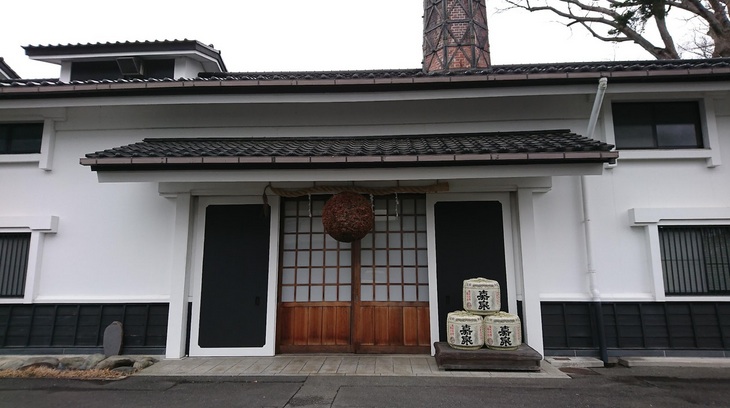
Brewery Tour Report: Tamura Shuzojo (Fussa, Tokyo)
Tamura Shuzojo is a small family-run brewery, established in 1822, which is famous for Kasen and Tamura. The brewery is owned by the Tamura family, which has been influential in the area for many generations, once serving as head of the village. Tradition requires that the head of the family take the name Hanjuro, Jubei, or Bunzaemon. The 9th head of the family established the brewery, which is currently managed by Hanjuro Tamura, the 16th head, pictured here with Sake Lovers’ Yuki and Kyoko:
The brewery is located on the banks of the Tamagawa Josui (Tamagawa Canal) in the quiet, peaceful city of Fussa, a commuter town in western Tokyo. Fussa station is on the JR Ome Line and can be reached in approximately 50 minutes from Shinjuku. Tamura Shuzojo is a short and pleasant walk (less than 10 minutes) from the station.
I had the pleasure of being guided around the brewery as part of a private visit in late January 2020. Many breweries are located in old buildings and install new technology and equipment within the constraints of those buildings. This means that many small family-run breweries are housed in old wooden buildings and one of the highlights of any brewery visit is seeing these old buildings and hearing about the way they are maintained. The inside of Tamura Shuzojo’s brewery is meticulously maintained to ensure no foreign particles contaminate their sake.
As is fairly common when visiting breweries, we were asked to take our shoes off and put on slippers at the entrance. We then changed our slippers again before going upstairs to the view the second floor.
We were also guided around the grounds.
The grounds are beautifully kept and the brewery goes to great lengths to maintain the buildings and trees. Many of the buildings, including the main brewing house (built in 1822) and warehouses (built in 1830 and 1862), have been registered as cultural properties. Some of the trees are thought to be 900 to 1000 years old.
The water in the neighboring canal (Tamagawa Josui) has been murky since a major typhoon hit the region in September 2019. The brewery expects it will be several years before the water runs clear again.
Although water from the canal is diverted off into the grounds, the brewery uses a separate water source, from a well on-site, to brew sake. The story goes that, given the location close to both Tamagawa (Tama River) and Tamagawa Josui (Tamagawa Canal), the brewery founder, Kanjiro Tamura, assumed he would have no problem finding water. However the water from the well he dug in the grounds was not suitable for brewing sake. He did not give up and continued to dig until he discovered a medium-hard water source. He rejoiced at his discovery, saying “Good spring! Joyous spring!” and named his sake嘉泉 (Kasen), using the kanji (Chinese characters) for joy (嘉) and spring (泉). Water diverted off from the canal is used on-site to power water wheels and in domestic use.
The Heisei Emperor and Empress visited the brewery in 2016, and small monuments have been erected in a number of spots around the grounds to commemorate their visit.
The brewery’s slogan is “和醸良酒” which the brewery translates in two ways “harmony brews quality sake” and “sake brews harmony”. The brewery purposely limits its production in order to focus on quality. Maboroshi-no-sake Kasen and Tamura are both fairly recent additions to their lineup, having been launched in 1973 and 2008 respectively. The brewery uses both Yamadanishiki rice from Hyogo Prefecture and Ginginga rice from Iwate Prefecture. Their master brewer, Mr. Takahashi, was trained by the Nanbu Toji guild, which is based in Iwate Prefecture.
The Japanese version of Tamura Shuzojo’s website includes an extensive list of seasonal pairing suggestions: http://www.seishu-kasen.com/koyomi
The common theme is traditional Japanese food such as simmered bamboo shoots with seaweed (wakatakeni) in spring, chilled tofu (hiyayakko) in summer, rice cooked with matsutake mushrooms (matsutake gohan) in autumn, and hotpot (nabe) in winter.
Their suggestions are also in keeping with the ideology of Sagen Ishizuka, a Meiji era nutritionist and food educator. Ishizuka recommended that
– bitter foods should be eaten in spring (bitter wild vegetables such as butter bur, rape blossom) to burn fat accumulated during winter,
– foods prepared with sweetened vinegar (summer vegetables such as cucumber, tomatoes) should be eaten in summer to cool down,
– pungent foods (grated daikon) should be eaten in autumn to encourage appetite, and
– oily foods (such as fish) should be eaten in winter to keep warm
At the time of our visit the Asahi Newspaper was running Tokyo Sake Project, a special project to promote Tokyo breweries. Visitors who posted about their visit on social media and showed the post to the brewery were given a container with ingredients to create a special cocktail.
Tamura Shuzojo’s sake is, of course, excellent but I highly recommend visiting the brewery to see their buildings and enjoy their landscaping.
Tamura Shuzojo Facts and Figures
| Name | Tamura Shuzojo 田村酒造場 |
| Prefecture | Tokyo |
| Founded | 1822 |
| Brands | Maboroshi-no-sake Kasen Tamura |
| Tours | Japanese only, reservations requiredTours are not available in December or JanuaryThe grounds can be accessed at any time when the gates are open |
| Access | 10-minute walk from Fussa Station on the JR Ome Line |
| Website | http://www.seishu-kasen.com/en |
About the writer:
Cathy Eberst
Cathy is a Japanese-to-English translator, specializing in legal documents. She has lived in Japan for over 20 years, living in Oita, Okinawa and Osaka Prefectures before settling in Tokyo in 2011. She rediscovered nihonshu in 2016 and has been making up for lost time ever since!




